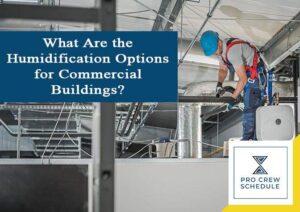There is a growing realization that commercial buildings should necessarily have some form of humidity control to deliver optimum productivity and occupant comfort. However, there’s an industry debate regarding the research on whether humidity levels might continue. HVAC system designers have tons of options when it comes in humidifying and dehumidifying the air in commercial buildings.
However, today’s HVAC design engineers’ design challenge is how to properly balance building construction and energy standards and codes like ASHRAE 55, 62, and 90. The fundamental theoretical analysis of peak heating, cooling, ventilation and humidification requirements of the building and the spaces within are simply the extension of engineering fundamentals. Hence, applying certain products and the controls of these products in a particularly dynamic environment occupied by humans becomes a significant challenge in controlling the HVAC systems’ load performance.
For this blog, we’re discovering the different humidification options intended for commercial buildings and why HVAC engineers should take this matter seriously.
1. Liability of Moisture
A precise way to come to grips with moisture’s significance in the building is to recall what the Building Design Guide states. Moisture control is becoming a significant liability issue ever since then. Recently, a very negative trend is being developed in the industry where buildings are making occupiers sick due to the growing mold. There’s no reason to explain why such mold contamination cases have grown. However, there are several fundamental factors that the HVAC system designers should keep in perspective.
- All potential relative building air pressure relationships, both internal and external, must be understood to prevent bringing untreated, undesirable moisture into the building.
- All water generation sources inside the building have to be reduced and understood.
- Moisture in the air and inside the building structure should be controlled.
Whether the moisture is directly from the outside, or any processes within the building, or being added to the HVAC air stream by process of humidification, an integrated approach is necessary. For HVAC engineers, deploying a scheduling project software like Pro Crew Schedule is a strategic approach, a wise move if being taken into action.
2. Psychrometric Analysis
Humidity is commonly talked about when it comes to relative humidity. Apparently, seven properties make up a psychrometric chart. This chart is used in the HVAC industry, especially in designing commercial building spaces to deliver comfort to the occupants. Here are the seven properties of the chart.
- Wet bulb and dry bulb temperatures
- Specific humidity
- Relative humidity
- Dew point
- Enthalpy
- Vapor pressure
When HVAC engineers design the HVAC systems for commercial buildings, modern standards and codes require them to take humidity into account more than ever. Beyond the occupants’ comfort concerns, some certain products like wood should have humidification tolerances. This tolerance has to be maintained in order to keep the product warranty and the performance.
It is where the harmonization and organization of the HVAC design engineers and the team have to strengthen. Doing so ensures that the humidification system will have the proper controls and the substantial capacity to maintain the required product humidity limits. Speaking of team collaboration, the implementation of construction crew management is essential to achieve a strong team connection without failing to complete tasks and other work commitments.
3. Standard Specifications
There are optional commercial building humidifier types that are further defined as follows:
- Heated-Pan Humidifiers
- Wetted-Element Humidifiers
- Atomizing Humidifiers
- Jacketed, Steam Humidifiers
- Direct-Steam-Injection Humidifiers
- Self-Contained Steam Humidifiers
- Portable Humidifiers
The specifications for both humidification for systems and products can be among the four forms of standard specifications that the Construction Specification Institute (CSI) outlines: reference standard, proprietary (open or closed), descriptive, or performance specifications. It becomes necessary to utilize a mix of these methods to specify the system and the product entirely in some cases.
As an HVAC engineer, you should have a clear and deep understanding of the CSI specification formats. It’s crucial to know that specifications constitute a significant part of the legal document in the contract between the contractor and the owner. Hence, it is fundamental to let the humidification products be specified concisely, clearly, correctly and entirely for the design intent.
4. Selection of Equipment for Peak conditions
The two familiar sources of humidity in commercial buildings are occupant load and ventilation load. Both these two significant contributors of humidity load, technically termed as latent load, must be calculated per load with the use of ASHRAE/ACCA standards. HVAC equipment is chosen to meet the loads, together with the latent load correctly. The two most vital aspects of understanding as an HVAC engineer are the following:
- The selection of equipment to necessarily meet the peak load is based on the total equipment performance, both from humidity and temperature load standpoint.
- Understanding equipment performance at part-load conditions/non-peak is necessary, including the system’s ability to manage and monitor both humidity and temperature independently.
So let’s begin with the basic understanding of equipment and load selection. The load consists of two major types, latent and sensible load. In the simplest format, the load formula will be Total Load = Latent Load + Sensible Load. Hence, in layman’s terms, the sensible load is the load being associated with the changing of dry-bulb temperature. In contrast, the latent load is the load commonly related to the heat contained in the water vapor or the moisture in the air.
5. Installation
Humidification system products and its controls should be commissioned and installed to ensure proper operation. When contractors do not follow the installation instructions, increasing liability and risk will happen, especially if there are resulting system issues. With the same regard, the HVAC engineer who reviews the installation must clearly understand the installation and code requirements.
The following statements from CSI regarding the installation are to be followed:
- All installation must be in accordance with the published recommendations from manufacturers.
- Installation must meet or exceed all valid state, federal, and local requirements, reference standards, and conform to authorities’ ordinances.
- You need to first understand the humidifier’s operation during peak and part-load conditions to ensure the installation cannot affect the actual performance. If the installation location shows, then it will be wise for you to submit RFI (Request for Information) early during the process.
6. Humidistats
In commercial applications, humidity sensors, typically called humidistat, are located in various and different areas. The location depends mainly on the control energy and system requirements. The location can be in the air handler, whether in the return air duct or occupied space. If it’s placed in an occupied space, it needs to be prioritized.
A humidistat is a particular device that measures humidity. Humidity measurement instruments typically rely on several other quantity measurements like pressure, temperature, mass, or electrical change in the substance. A hygrometer is one device used by HVAC professionals, especially when measuring moisture content within the atmosphere. A humidistat has an excellent measurement reading since it gives a realistic room moisture level. It’s a convenient monitoring tool.
Calibration, accuracy, and commissioning are the three most important aspects contributing to a humidity sensor’s longevity.
Why Use HVAC Subcontractor Scheduling Software?
Just as crucial as determining several humidification options, investing in an advanced software application is considered a necessary action. More and more HVAC business owners realize the importance of having an effective project management tool that will help them and their employees better control their business procedures and processes. One of the benefits of this HVAC software solution is to ensure that HVAC services and projects can be successfully completed.
Pro Crew Schedule is the leading project task management software specifically designed to support the many ways HVAC contractors tend to work and plan. Among other scheduling software available in the market, Pro Crew Schedule stands out from the rest due to the following advantages:
- Document sharing and control
- Time-tracking and monitoring
- Crew and resource management
- Task prioritization
- Easy to use and user-friendly
- Better project management for construction projects
- Fast notifications and updates
- Real-time team collaboration
Getting the best construction management software with outstanding features and solutions is vital for your HVAC business, especially if you want to expand in taking over a huge market share. This PM application helps promote efficient business processes, increase investment return, and eventually complete any HVAC projects and services faster. If you’re new to this tech, Pro Crew Schedule is available to explore. Request for a FREE live demo!
Key Takeaways
When it comes to delivering required and desired space conditions in a commercial building, choosing suitable humidification options is vital. There might be an instance where the applied principles become too focused on not providing the proper controls and products and meeting the required system standards. That is why, for today’s commercial building, HVAC engineers, contractors, and even code authorities must continue to discover other options that optimize productivity and comfort for the occupants.







